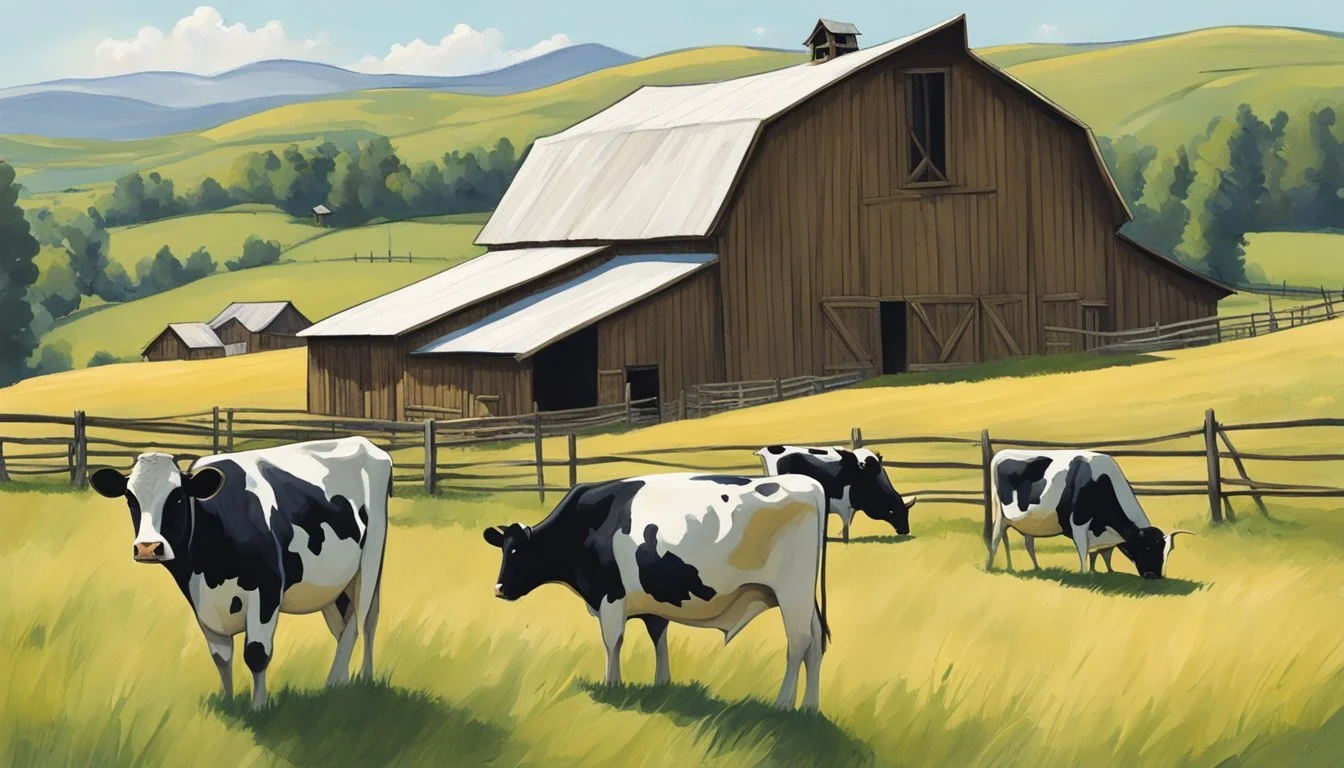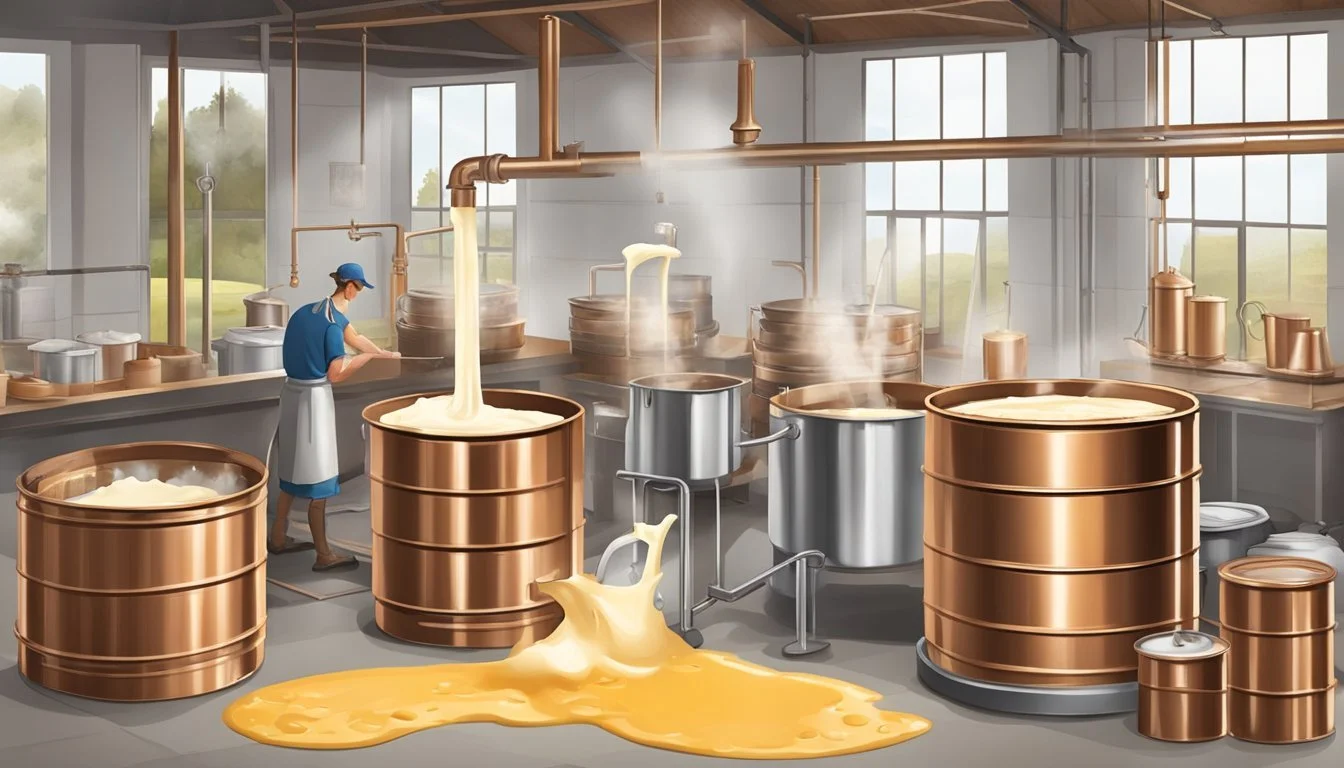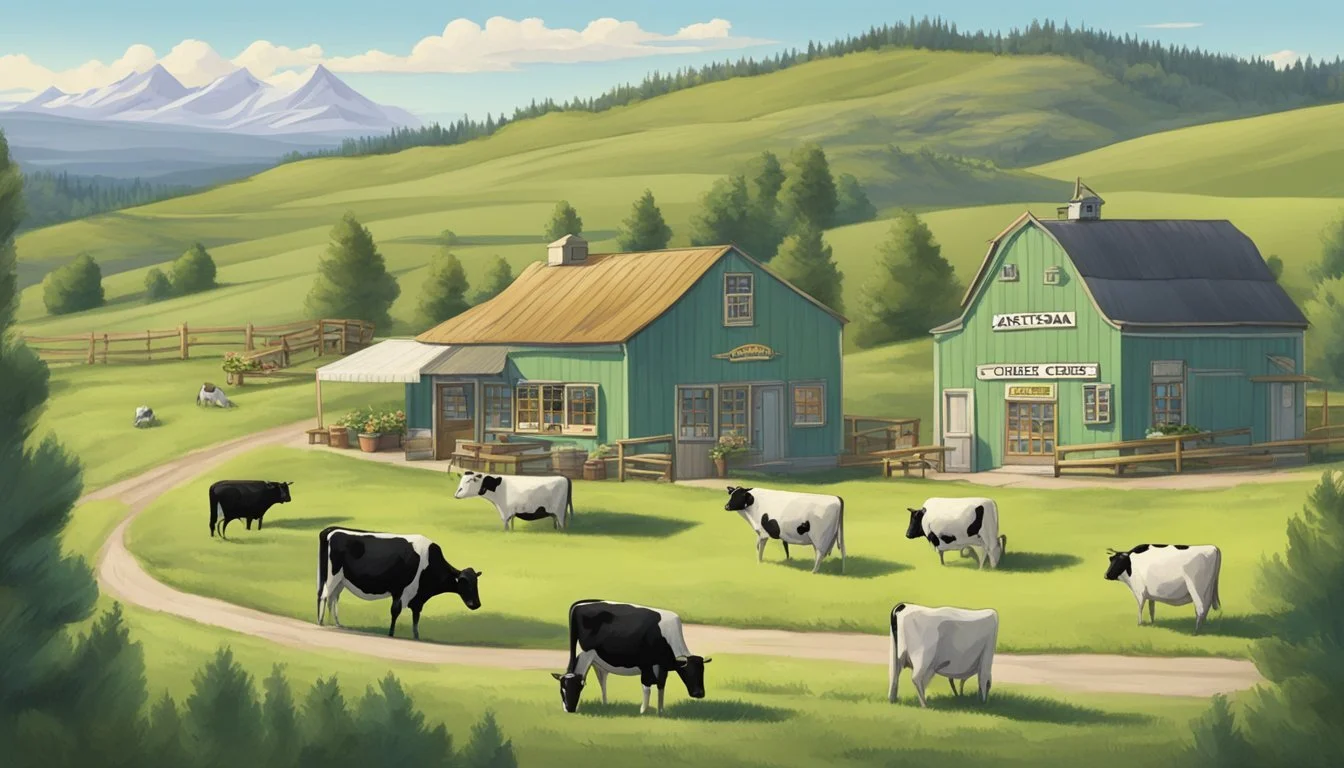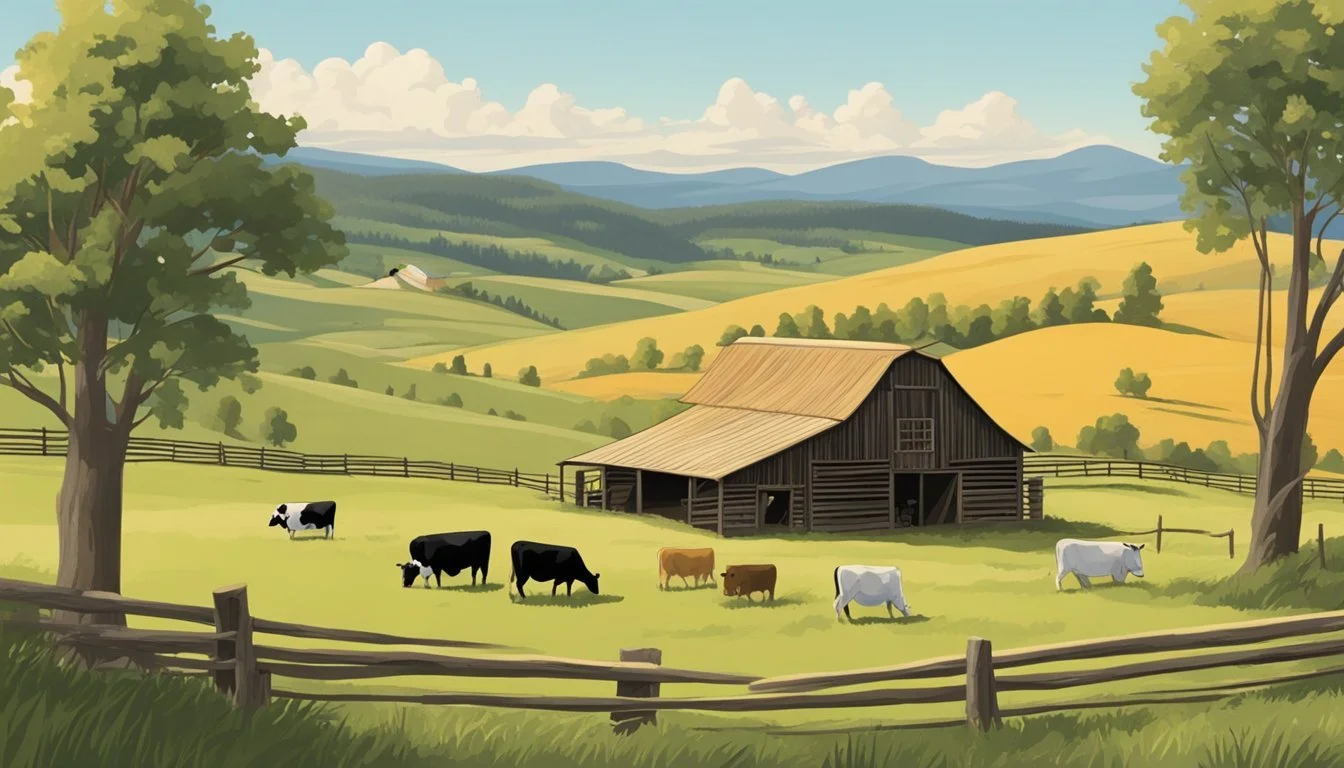Wyoming Artisan Cheese
Discovering the State's Finest Craftspeople
Wyoming's artisan cheese (how long does cheese last?) scene is blossoming amid the state's expansive landscapes and robust agricultural heritage. Small-scale cheese (What wine goes well with cheese?) producers are leveraging the pristine environment and local milk to create high-quality, unique cheeses that reflect the terroir of the region. Across the state, from the Big Horn Mountains to the quiet town of Star Valley, cheesemakers are crafting products that range from traditional cave-aged varieties to innovative creations that challenge the palate.
These cheese artisans in Wyoming prioritize traditional methods, producing raw, farmstead, and sheep's milk cheeses (What wine goes well with sheep's milk cheeses?) along with other varieties. The commitment to craftsmanship and quality is evident in each wheel and block of cheese produced. As these cheese artisans operate within a state that allows the sale of raw milk and its products, they maintain a connection to old-world techniques while embracing the freedoms that foster their creativity and the distinctive character of Wyoming's artisan cheeses.
The state's cheese offerings not only attract locals but also draw in visitors on a culinary journey. Enthusiasts can find a curated selection of both international and Wyoming-made cheeses at specialty shops like Chalk N' Cheese in Laramie, serving as hubs for cheese education and appreciation. These shops and farmsteads not only sell cheese but also play a pivotal role in the community, connecting consumers with the stories and processes behind their food.
History of Wyoming Artisan Cheese
Artisan cheese production in Wyoming reflects a commitment to quality and tradition. Wyoming's cheese history is informed by its unique legal environment allowing farmers to sell raw milk and products made from it, fostering the artisan cheese industry.
Farmstead Practices: Many Wyoming cheese producers embrace farmstead practices, meaning cheese is made on the same farm where the milk is produced. This practice ensures impeccable freshness and quality control, which are paramount in the cheesemaking process. For example, Red Fork Farmstead specializes in cave-aged, raw sheep's milk cheese in the Big Horn Mountains.
French Influence: The artisan cheese scene in Wyoming has drawn international expertise, with artisans like Suzanne Mate Lecuyer from Paris bringing techniques learned in the French Alps. Her choice to settle in Wyoming was influenced by the state’s supportive legislation for raw milk products.
Diversity in Production: Wyoming's artisan cheese producers are not only limited to cow's milk. There is a growing diversity in milk types, including sheep and goat, which contributes to the variety of cheeses available. These options are part of the broader trend in the American cheese industry, which has seen a significant increase in artisan cheesemakers since the late 1970s.
Cultural Significance: Cheese production in areas such as Star Valley connects to historical modes of commerce, with residents traditionally banking and loading their cheese in nearby rail-line-connected Montpelier, Idaho.
Producers in Wyoming continue to forge a niche in the artisan cheese market, contributing to the state's reputation for high-quality, handcrafted products.
Types of Wyoming Artisan Cheese
Artisan cheese makers in Wyoming are known for their range of distinctive cheeses, derived from the rich milk of local sheep and cows. These cheeses vary in flavor, texture, and maturation processes, utilizing a mix of traditional methods and unique ingredients.
Cheddar and Hard Cheeses
Wyoming’s climate and terroir contribute to the production of high-quality cheddar cheeses with a characteristic sharpness. The selection includes aged cheddars that are often cave-aged to enhance their depth of flavor. Utilizing raw milk and a careful aging process, these hard cheeses develop a complex taste profile. Local producers integrate various cultures and levels of butterfat, emphasizing quality and taste that reflect the region's distinctive character.
Soft Cheeses and Brie
Soft cheeses (What wine goes well with soft cheeses?), including varieties of brie, are notable for their creamy texture and mild flavors, which are developed through a careful balance of milk, cream, and specific bacterial cultures. Artisan cheese makers in Wyoming employ gentle handling and precise salt additions to create these delicate cheeses. These soft cheeses are generally younger with a higher moisture content, making them a perfect canvas to reflect the nuanced flavors of the local milk.
Blue Cheese and Specialty Varieties
Specialty cheeses from Wyoming include a variety of blue cheeses, (What wine goes well with blue cheeses?) which are punctuated by the bold streaks or pockets of blue mold responsible for their distinctive spicy to sharp flavors. Each cheese maker adds uniqueness to the traditional blue cheese-making process, often aging them to perfection to achieve the desired intensity. These blue cheeses, along with other specialty varieties, feature local ingredients when possible, adding authenticity to each batch produced.
Cheese-Making Process
Artisan cheese-makers in Wyoming craft their products with attention to quality and traditional techniques. This section explores the nuanced process behind creating these gourmet cheeses.
Raw vs Pasteurized Milk
The choice between raw and pasteurized milk is pivotal in artisan cheese-making. Raw milk cheeses are made from unaltered milk retaining its natural flora, while pasteurized milk has been heat-treated to kill bacteria. Wyoming's unique laws allow for the sale of raw milk cheeses, provided they meet health standards.
Culturing and Curd Processing
Cheese begins with the introduction of cultures to milk or cream, initiating fermentation. These cultures comprise bacteria that convert lactose into lactic acid, thickening the milk into curds. Artisans then cut, cook, wash, or stretch these curds depending on the cheese variety, affecting texture and moisture.
Aging and Maturation
Maturation involves aging cheese under controlled conditions to develop flavor and texture. This can range from weeks to years. Artisan cheeses are often cave-aged, a traditional practice that utilizes the consistent temperature and humidity of a cave to mature cheese uniformly.
Flavoring and Texturing
The final character of artisan cheese comes from adding elements like salt, herbs, or spices. Salt enhances flavor and acts as a preservative. The incorporation of various flavorings and techniques in texturing creates the distinct profiles of cheeses that vary from creamy to crumbly, mild to pungent.
Sourcing Ingredients
In the craft of artisan cheesemaking, the caliber of ingredients shapes the final product. Wyoming's unique environment and dedicated farmers supply high-quality raw materials that are crucial for creating distinctive and premium artisan cheeses.
Local Wyoming Milk
Wyoming dairy farmers predominantly raise Jersey and other cow breeds known for their rich and flavorful milk. This foundation ingredient is sourced from animals often grazing on Wyoming's grasses and alfalfa, which contributes to a unique taste profile influenced by the local terroir.
Natural Resources and Terroir
The state's natural resources, particularly its pure water and lush mountain grass, play a vital role in the terroir of Wyoming cheeses. The water from mountain run-offs irrigates the fields, leading to rich and nutritious grasslands, which, in turn, influence the milk's subtleties.
Sustainable Agriculture Practices
Sustainable agricultural practices are integral to Wyoming cheese producers, who often implement rotational grazing and organic farming methods. These practices ensure not just the quality of the milk, but also the long-term health of the land, supporting Wyoming's commitment to sustainable agriculture.
Selecting Quality Additives
Craft cheese in Wyoming is often enhanced with quality additives like Himalayan salt, which imparts a flavor depth while also acting as a natural preservative. Artisan cheesemakers selectively use herbs and spices, sourced for their purity and contribution to the cheese's overall flavor complexity.
Pairing and Consumption
In the rich landscape of Wyoming's dairy offerings, artisan cheese takes a front seat, integrating seamlessly with a selection of fine wines and accompanying dishes. The process of pairing these cheeses with the perfect wine or side dish is an art that enhances the tasting experience.
Cheese and Wine Pairings
Wyoming's artisan cheese varieties, from the creamy to the aged, pair exceptionally with a range of wines. When considering wine pairings, it's essential to balance the intensity of the cheese with an appropriate wine:
Soft Cheeses: A soft cheese generally pairs well with a light-bodied white wine with a hint of sweetness. For example, a creamy Brie might be paired with a Riesling.
Aged Cheeses (What wine goes well with aged cheeses?): An aged cheese demands a wine with more structure and body. A sharp aged cheddar pairs nicely with a full-bodied Cabernet Sauvignon.
Cheese Boards and Serving
The presentation of Wyoming artisan cheeses is an essential component of consumption. A cheese board serves as the center stage for these delectable creations. When assembling a cheese board:
Material: Opt for wood or resin art boards like those crafted from maple hardwood; they are both functional and aesthetically pleasing.
Use a variety of cheeses, charcuterie (What wine goes well with charcuterie?), and breads or crackers to offer contrast in textures and flavors.
Accompaniments and Side Dishes
Accompaniments provide another layer of flavor and texture to artisan cheese. They should complement rather than overpower the cheese itself:
Charcuterie: Various meats can enhance the savoriness of the cheese. Prosciutto and salami are popular choices.
Fruit and Nuts: Apples, pears, or walnuts (how long do walnuts last?) can be paired with stronger cheeses to balance the flavors.
By selecting the appropriate wines, presentation materials, and accompaniments, one can craft an indulgent cheese tasting experience that showcases the best of Wyoming's artisanal cheeses.
Artisan Cheese Industry in Wyoming
The Wyoming artisan cheese industry, marked by its sustainable practices and farmstead operations, contributes uniquely to the state's economy, fostering a market rich in high-quality cheese products.
Local Artisan Cheese Producers
Local producers in Wyoming have carved out a niche for themselves by creating raw, cave-aged, sheep's milk cheese and other specialty cheeses. Artisan operations like Red Fork Farmstead operate from family ranches in the picturesque Big Horn Mountains, elaborating on traditional methods to innovate within the cheese-making process. Shops such as Chalk N' Cheese in Laramie provide an avenue for consumers to purchase these artisanal products directly. Makers have also harnessed state policies that allow for the sale of raw milk products, enhancing their product lineup.
Economic Impact of Cheese Production
In Wyoming, artisanal cheese production is more than a craft; it's a vital part of the local economy. The teams behind Wyoming's artisan cheeses contribute to the state's economy, providing not only food products but also supporting tourism through cheese-related day trips and tastings. Cheese shops stimulate local commerce by encouraging both residents and visitors to purchase local, sustainably made goods, which can lead to increased job opportunities and support for the farming community.
Future Trends and Challenges
As consumer preferences shift and demand for artisanal, locally sourced foods grows, Wyoming's cheese producers face both opportunities and challenges. Keeping pace with market trends while maintaining a commitment to quality and sustainable methods is crucial. Future trends may include the integration of innovative aging techniques, the development of new flavors, and a larger focus on farmstead production to meet the increasing consumer demand for transparent and natural food sources. Adapting to these trends while overcoming challenges such as regulatory changes and economic pressures will determine the industry's onward journey.
Purchasing Wyoming Artisan Cheese
Wyoming offers a unique selection of artisan cheeses crafted with care from locally sourced raw milk, ensuring high-quality ingredients and distinctive flavors. Cheese aficionados can explore various cheese shops for a personalized experience.
Guide to Local Cheese Shops
Jackson: For those near Jackson, Aspens Market, located at 4015 West Lake Creek Drive in Wilson, is approximately 7 miles west of the city and offers an array of grocery items along with an extensive cheese case focusing on artisan varieties.
Star Valley: Cheese lovers can also visit Star Valley, where French artisan cheesemakers apply traditional methods learned in the French Alps to create exceptional products using state-allowed raw milk.
Table of Notable Cheese Shops in Wyoming:
Shop Name Location Specialties Aspens Market Wilson (near Jackson) Diverse selection of artisan cheese Red Fork Farmstead Big Horn Mountains Farmstead, sheep's milk cheese
Tips for Selecting Quality Cheese
When selecting artisan cheese in Wyoming, consider both butterfat content and maturation period. Cheeses with higher butterfat offer a creamier texture, and the maturation length can significantly influence flavor depth.
List for Evaluating Quality Cheese:
Texture and Body: Feel the cheese; it should reflect its type, whether soft or firm.
Aroma: Smell the cheese for freshness and a hint of what to expect in taste.
Origin: Inquire about the origins of the milk and the farm's practices for insight into the cheese quality.
Understanding Cheese Labels and Descriptions
Artisan cheese labels in Wyoming often include critical information such as the type of milk used (e.g., sheep's), whether it's raw or pasteurized, and the cheese's maturation period.
Label Reading Tips:
Ingredients: Look for a short list of high-quality, natural ingredients such as cultures and milk.
Cultures: Specific cultures mentioned can hint at the cheese's flavor profile.
Raw Milk: Indicates traditional processing, which is common in Wyoming's artisanal cheese industry.
By understanding these key elements, purchasers can make informed decisions and enjoy the rich, diverse flavors that Wyoming's artisan cheese shops have to offer.
Preservation and Storage
Proper storage is essential in preserving the quality and extending the freshness of artisan cheeses. Cheeses require specific conditions such as temperature and humidity to maintain their optimal characteristics.
Best Practices for Cheese Storage
One should store cheese at a constant temperature between 35°F and 45°F, ideally in a dedicated cheese drawer or a less humid section of the refrigerator. To maintain the right humidity, it’s helpful to keep cheeses in a dedicated cheese container or a specialized storage system like the Cheese Grotto, which emulates the conditions of cave aging.
Wrapping: Depending on the type of cheese:
For soft cheeses, use wax paper or cheese paper to allow the cheese to breathe.
For hard cheeses, tightly wrapped plastic can prevent them from drying out.
Location: Keep cheese away from strong-smelling foods to avoid flavor transfer.
Tips for Extending Cheese Freshness
Maximizing freshness hinges on control over the cheese's environment:
Unopened Cheese: Store in its original packaging; this maintains the cheese's quality and ensures it lasts for several weeks.
Opened Cheese: After opening, rewrap the cheese tightly after each use to limit exposure to air and contaminants.
Handling: Use clean utensils to handle the cheese, preventing the introduction of bacteria which can degrade the product.
Note: Artisan cheeses vary greatly; one should always consider the specific type of cheese and adjust storage practices accordingly.
Craftsmanship in Cheese-Related Products
The artisanal cheese movement in Wyoming is complemented by an array of handcrafted products essential for the serving and enjoyment of these specialty cheeses. These items are not just tools but also represent the artisanship that aligns with the quality and character of Wyoming’s cheese.
Handcrafted Cheese Boards
Materials and Craftsmanship: Artisans commonly select premium edge grain hardwood such as maple for crafting cheese boards, prioritizing both durability and beauty. The edge grain provides a sturdy cutting surface that showcases the character of the wood.
Design Elements: A stylish and functional design often includes rounded edge profiles and sometimes incorporates resin art for a distinct aesthetic. Every cheese board is handmade, ensuring a unique character and quality.
Unique Cheese Utensils
Construction: Cheese utensils crafted by artisans embody a marriage of form and function. Use of wood and other high-quality materials ensures these items are not only durable but also boast an appealing look.
Variety and Features: With options ranging from soft cheese knives to hard cheese planes, each utensil offers a handle designed for comfort and ease of use. Handcrafted details often reveal the maker's mark, adding a personal touch to each piece.
Care and Maintenance of Cheese Accessories
Proper care extends the life and preserves the quality of cheese accessories. Focusing on materials, such as wood, and understanding their unique maintenance needs ensures long-lasting and safe use.
Cleaning and Protecting Wood Products
Wooden cheese boards and handles require specific attention due to their organic and porous nature. To clean such items:
Use a soft cloth or sponge with warm water and a gentile detergent.
Rinse thoroughly to remove any soap residue.
Immediately dry with a towel to prevent warping or cracking.
For protection:
Regularly apply food-safe wood wax or oil to maintain the wood's natural luster.
Ensure that wax or oil is heat-resistant and suitable for maintaining a food-safe surface.
Avoid using abrasive cleaners or scrubbers that can damage the wood grained-edge and handmade details. Also, never place wood products in the dishwasher, as the harsh heat and detergents can degrade the wood's durability and finish.
Long-Term Care for Cheese Boards
Long-term maintenance of cheese boards is about preserving both the material and usability. To ensure longevity:
Store in a cool, dry place to prevent the wood from swelling or shrinking.
Avoid extreme temperatures, as they can cause splitting or warping of the wood's dimensions.
Wooden boards with handles should be hung by the handle when not in use to keep them straight and prevent bending.
Remember, consistent care and maintenance of your cheese board will not only enhance its durability but also sustain its handcrafted beauty and food-safe quality over time.
Conclusion
Wyoming's artisan cheese industry embodies a unique blend of tradition and innovation, anchored in the state's commitment to quality and sustainability. The artisan cheesemakers of Wyoming, such as Suzanne Mate Lecuyer in Star Valley and the team at Red Fork Farmstead in the Big Horn Mountains, have carved out a distinctive niche by leveraging the state's supportive regulations and the rich, local terroir.
These producers often utilize raw milk to create cheeses that pay homage to time-honored methods, imparting complex flavors akin to those found in the cheeses of the French Alps. The focus on farmstead production reflects a dedication to crafting cheeses that not only showcase Wyoming's unique pastoral landscape but also maintain ecosystem health.
Sustainability in Wyoming's cheese production is often linked with the small-scale nature of these operations—ensuring minimal environmental impact while generating locally-adored products. The shift towards fewer, but finer, artisan cheeses is indicative of a desire to maintain high quality rather than to proliferate quantity.
Wyoming's cheese shops, such as Chalk N' Cheese in Laramie, champion the symbiosis between luxury and locality by offering a selection of both global and Wyoming-made cheeses. This endeavor enriches the culinary experience of residents and visitors alike.
Artisan cheese in Wyoming is more than a comestible; it is a statement of pride and a testament to the possibilities within a region ripe for agrarian craftsmanship. With each slice of cheese, there is a narrative of perseverance, adaptation, and the valorization of the artisan spirit.













